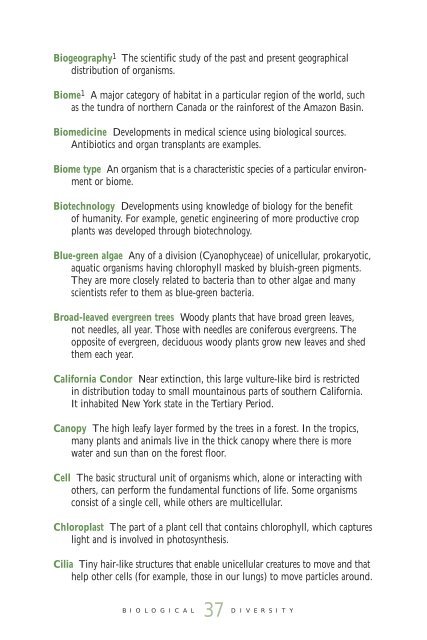Download Biological Diversity - New York State Museum
Download Biological Diversity - New York State Museum
Download Biological Diversity - New York State Museum
You also want an ePaper? Increase the reach of your titles
YUMPU automatically turns print PDFs into web optimized ePapers that Google loves.
Biogeography 1 The scientific study of the past and present geographical<br />
distribution of organisms.<br />
Biome 1 A major category of habitat in a particular region of the world, such<br />
as the tundra of northern Canada or the rainforest of the Amazon Basin.<br />
Biomedicine Developments in medical science using biological sources.<br />
Antibiotics and organ transplants are examples.<br />
Biome type An organism that is a characteristic species of a particular environment<br />
or biome.<br />
Biotechnology Developments using knowledge of biology for the benefit<br />
of humanity. For example, genetic engineering of more productive crop<br />
plants was developed through biotechnology.<br />
Blue-green algae Any of a division (Cyanophyceae) of unicellular, prokaryotic,<br />
aquatic organisms having chlorophyll masked by bluish-green pigments.<br />
They are more closely related to bacteria than to other algae and many<br />
scientists refer to them as blue-green bacteria.<br />
Broad-leaved evergreen trees Woody plants that have broad green leaves,<br />
not needles, all year. Those with needles are coniferous evergreens. The<br />
opposite of evergreen, deciduous woody plants grow new leaves and shed<br />
them each year.<br />
California Condor Near extinction, this large vulture-like bird is restricted<br />
in distribution today to small mountainous parts of southern California.<br />
It inhabited <strong>New</strong> <strong>York</strong> state in the Tertiary Period.<br />
Canopy The high leafy layer formed by the trees in a forest. In the tropics,<br />
many plants and animals live in the thick canopy where there is more<br />
water and sun than on the forest floor.<br />
Cell The basic structural unit of organisms which, alone or interacting with<br />
others, can perform the fundamental functions of life. Some organisms<br />
consist of a single cell, while others are multicellular.<br />
Chloroplast The part of a plant cell that contains chlorophyll, which captures<br />
light and is involved in photosynthesis.<br />
Cilia Tiny hair-like structures that enable unicellular creatures to move and that<br />
help other cells (for example, those in our lungs) to move particles around.<br />
B i o l o g i c a l<br />
37 D i v e r s i t y
















